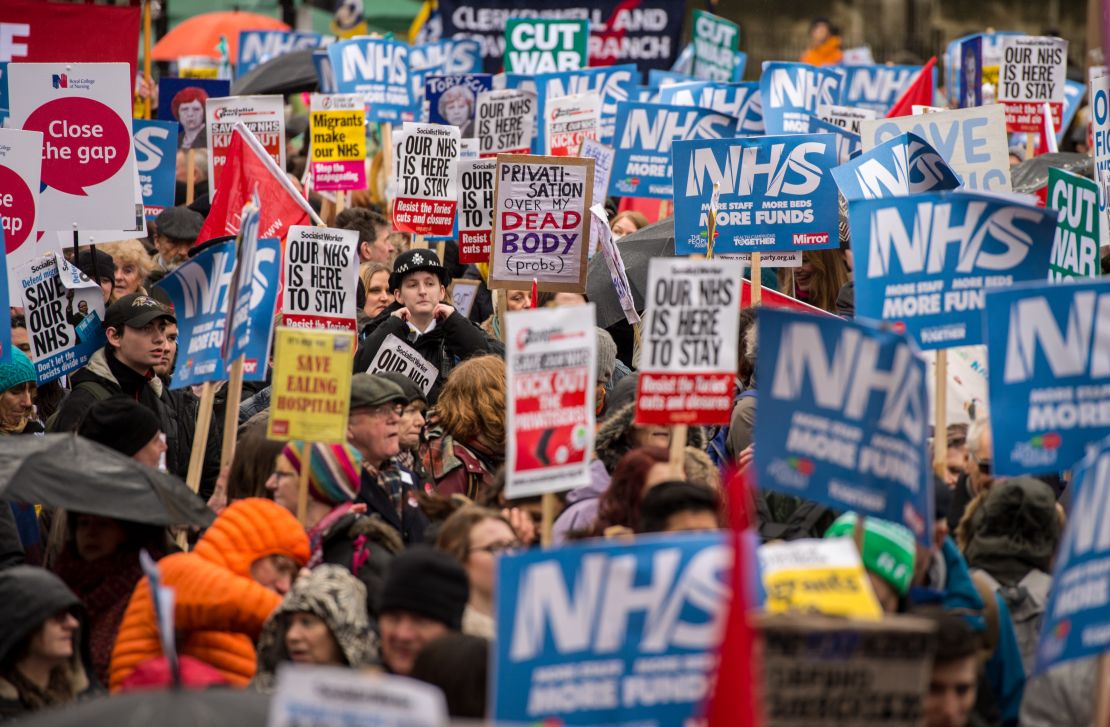Story highlights
The UK is one of the lowest health-care spenders among G7 nations
Its National Health Service has found itself strained amid budget cuts
The idea is simple: You are feeling unwell. You go to your local medical office or hospital, and within a few hours, you’re seen by a doctor, given a diagnosis and prescribed the necessary treatment.
Perhaps most important: There is no bill at the end of your visit.
Regardless of your income, employment status, address or any other factor, this provision is free at the point of care.
This is what more than 65 million people in the United Kingdom have come to expect from their country’s health care system, the National Health Service, which celebrates its 70th anniversary this year.
The population’s health care is funded through taxes and compulsory contributions deducted from income, which go toward many state benefits. According to data from the Organisation for Economic Co-operation and Development, the UK spends an average of $4,192 per person for a universal system.
But alarming headlines, protests on the streets of London and a tweet from the President of the United States have the eyes of the world on the UK, questioning whether this long-revered health care model has a place in today’s financial climate.
“Thousands of people are marching in the UK because their U(niversal) system is going broke and not working,” President Donald Trump tweeted of the thousands who demonstrated February 3 for more money to finance the service.
British Health Secretary Jeremy Hunt soon fought back, defending the system whose budget he determines and tweeting that 28 million people in the United States “have no cover.”
Prime Minister Theresa May responded that she was proud of Britain’s health service.
Compared with the complexities of obtaining and being eligible for insurance, the idea of a national health service is indeed simple – to its users. For those financing it, not so much.
NHS funding is one of the most hotly contested issues in British politics, with all parties wanting to know how to maintain universal access to care at a time of rising costs and demand. The system seems to be splitting at its seams. Is it broken?

Burned-out doctors
“The system we have is about collective funding of health care,” said Danny Mortimer, deputy chief executive of the NHS confederation, which represents health organizations in England, Wales and Northern Ireland, and chief executive of NHS Employers
But Mortimer admits that an enhancement is needed, determining a more coherent way of setting finances moving forward. “We’ve had a long period of austerity,” he said. The result: “Health care hasn’t kept pace with the demand on services.”
The slower growth in expenditure is part of the government’s austerity drive since 2010.
According to the Kings Fund, an independent health care charity, the National Health Service is more than halfway through its most austere decade ever. Figures from the World Bank reflect this: In 2009, the UK spent 9.8% of its GDP on health care; by 2014, it fell to 9.1%.
However, the UK is one of the lowest health care spenders among developed G7 countries. The US government and its citizens spent 17.2% of GDP on health care in 2017.
But this winter, thousands of non-emergency procedures were canceled and a strained system was put in the spotlight amid a flu outbreak that pushed the health service to its limit. Despite planning for a surge in cases, routine procedures were canceled to free up beds, yet emergency rooms were still overwhelmed with tens of thousands of people each day.
In January alone, 2 million people went to emergency rooms in England, with more than a quarter of them admitted, and 15% of them waited longer than four hours to be seen. The NHS goal is for under 5% of people to wait longer than four hours.
Patients are dying in hallways while they wait for beds, senior emergency room doctors told CNN in an earlier report.
“We started winter pressures early this year, in October,” said Ghislaine Stephenson, a senior pediatric nurse at Whipps Cross University Hospital in East London. There, an estimated 300 to 400 people came through the doors of the emergency department each day, and 90% of people were seen in the emergency room within four hours, she said.
“The department is very busy,” she said, describing it as churning constantly to ensure that people are seen within the times required. “The first few weeks of January were a challenge,” taking her out of the office and onto the hospital floor whenever possible so that all hands were on deck.
Stephenson believes one key factor behind this constant demand on emergency rooms is the strain and lack of funding for primary care services: local general practitioners, who should be the first port of call for anyone with mild or moderate illness.
Almost a decade of declining funding for this aspect of care resulted in overwhelmed local practices and ailing people unable to get the appointments they needed, instead resorting to an emergency room, she said.
“We need to sort out primary care to stop people coming in in the first place,” Stephenson said.
She gave the example of nursing homes where general practitioners would previously have made routine visits to check up on many patients at once. Today, this is virtually nonexistent, and with the population only getting older, the demand from this demographic is rising.
General practitioners “are on their knees,” she said.
A strained system
“These are the inevitable consequences,” said Dr. Helen Stokes-Lampard, chair of the Royal College of General Practitioners. Her own practice is based in Lichfield, a relatively affluent cathedral city in the center of the UK.
Although face-to-face care with regular patients should be the most rewarding part of health care, she said, “if you don’t feel like you can offer high-quality care, that leaves you stressed and burned out.”
Demands on doctors and the need for extended hours to provide care as demand rises have made primary care undesirable for doctors, Stokes-Lampard believes. “The UK is short on GPs,” she said.
Because of these austere times, Stokes-Lampard’s practice merged with a neighboring one last year to provide more resilience. Earlier in 2017, two of eight doctors at her original practice fell sick, removing 25% of her team for most of the year amid an influx of norovirus and the flu.
“The whole system had been strained, so we decided to merge,” she said. “This is a direct consequence of changes happening in the NHS.” In December, the practice changed from one serving 8,000 patients to one managing 28,000.
But there is potential hope on the horizon, Stokes-Lampard said, in the form of GP Forward View. This commitment by the UK government would provide an extra £2.4 billion a year to support services and train an additional 5,000 general practitioners and 5,000 other clinical support staff by 2020, as well as giving people access to a local GP from 8 a.m. to 8 p.m every day.
It also comes with a commitment for general practitioner services not to receive less than 10.5% of NHS resources, Stokes-Lampard said; it currently receives just 8.7% despite being the front line of health care services.
Declining budgets have led to this need and a defensive, cautious way of practicing medicine, she said. Canceled operations this winter have also not helped, she added, as these patients inevitably come back to their local doctors.
“There are promises coming, but it will take time for them to be fulfilled,” Stokes-Lampard said.
Less care after the hospital
The other factor putting increasing strain on hospitals is at the other end of the health care chain: the inability to leave.
Many patients require rehabilitation or monitoring once they leave the hospital to ensure that they take medications properly, for example. But declining funding for adult social care services, such as home carers, occupational therapists and district nurses, has made these services less available to patients.
There has been a “sustained period of disinvestment, leaving a deficit in these services,” Mortimer said. “This makes it harder to transfer care out into the community from hospital.”
Spending on adult social care by local authorities in the UK fell by 8% between 2009 and 2016, from £18.4 billion to under £17 billion.
The result of continuously declining services is an increase in the number of people coming into hospitals – due to poorly resourced primary care – and a decrease in people moving out. “It’s both ends, really,” he said.
Away from emergency room attendance, this also affects the ability to schedule routine surgeries and procedures as beds remain occupied. In 2013, the average wait for general surgery was 8½ weeks, Mortimer said, but in 2017, it was 9½ weeks. “It’s slipped.”
A need for ‘strategic investment’
In the 2017 fall budget, the UK government announced £6.3 billion (about $8.2 billion) of new funding for the NHS in England, including £2.8 billion over the next two years for day-to-day services and £3.5 billion of capital investment by 2022-23.
But some commentators say there needs to be a fuller rethink. A 10-member panel set up by the Liberal Democrats, a centrist political party, has stated that an extra £4 billion should be spent next year, with an extra £2.5 billion for both 2019 and 2020.
But is more money enough? When it comes to social care services, yes, Mortimer said. “For social care, there is an urgent need to fund these services,” he said, which is particularly crucial for the growing elderly population.
According to the Office for National Statistics, almost 18% of the UK population in 2014 was over the age of 65. “That is the most pressing issue now in terms of the NHS,” Mortimer said.
Join the conversation
He also said better strategy is needed when budgets and finances are allocated to ensure security in the long term, suggesting that systematic procedures be put in place to inform how much spending is actually needed.
Stokes-Lampard agreed that a more sustainable approach was needed to fund the NHS long-term, for at least a decade, adding that it should be taken away from party politics.
Stephenson said more budget is also the key to more staffing, another issue facing the NHS amid restrictions on permits and falling numbers of applicants from the European Union.
“It’s not just doctors,” she said; resources are needed for more support staff, such as health care assistants, as well as community provisions to enable better care services so people can get out of the hospital and back into their home environments.
With fears over staffing also looms Brexit, the departure of the UK from the European Union, which for now Mortimer said brings uncertainty and affects migration.
Stoke-Lampard added that 11% of general practitioners in England come from the EU and said that if visas are changed, it would be a “dreadful situation.”
The reality, however, is that this hasn’t caused a change, she said – “but an increase in anxiety.”
CNN’s James Masters and Alanna Petroff contributed to this report.




















